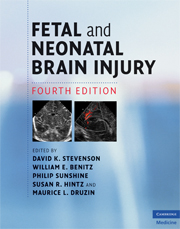Book contents
- Frontmatter
- Contents
- List of contributors
- Foreword
- Preface
- Section 1 Epidemiology, pathophysiology, and pathogenesis of fetal and neonatal brain injury
- Section 2 Pregnancy, labor, and delivery complications causing brain injury
- Section 3 Diagnosis of the infant with brain injury
- Section 4 Specific conditions associated with fetal and neonatal brain injury
- Section 5 Management of the depressed or neurologically dysfunctional neonate
- Section 6 Assessing outcome of the brain-injured infant
- 45 Early childhood neurodevelopmental outcome of preterm infants
- 46 Cerebral palsy: advances in definition, classification, management, and outcome
- 47 Long-term impact of neonatal events on speech, language development, and academic achievement
- 48 Neurocognitive outcomes of term infants with perinatal asphyxia
- 49 Appropriateness of intensive care application
- 50 Medicolegal issues in perinatal brain injury
- Index
- Plate section
- References
50 - Medicolegal issues in perinatal brain injury
from Section 6 - Assessing outcome of the brain-injured infant
Published online by Cambridge University Press: 12 January 2010
- Frontmatter
- Contents
- List of contributors
- Foreword
- Preface
- Section 1 Epidemiology, pathophysiology, and pathogenesis of fetal and neonatal brain injury
- Section 2 Pregnancy, labor, and delivery complications causing brain injury
- Section 3 Diagnosis of the infant with brain injury
- Section 4 Specific conditions associated with fetal and neonatal brain injury
- Section 5 Management of the depressed or neurologically dysfunctional neonate
- Section 6 Assessing outcome of the brain-injured infant
- 45 Early childhood neurodevelopmental outcome of preterm infants
- 46 Cerebral palsy: advances in definition, classification, management, and outcome
- 47 Long-term impact of neonatal events on speech, language development, and academic achievement
- 48 Neurocognitive outcomes of term infants with perinatal asphyxia
- 49 Appropriateness of intensive care application
- 50 Medicolegal issues in perinatal brain injury
- Index
- Plate section
- References
Summary
Introduction
Perinatal hypoxic-ischemic brain injury is an important and often troublesome medicolegal problem for practicing physicians. Brain injury to infants occurring during the perinatal period is probably the most common cause of severe long-term neurological deficit in patients, and consequently the incentive for legal action is high.
Although vast advances in care have taken place during the past several decades in the practice of perinatal medicine, the incidence of brain injury and its sequelae has not seen a significant decline. Litigation involving these types of injuries has remained a constant over many years despite endeavors in education of both physicians and patients, and improvements in care. This chapter will attempt to explore and explain the manner in which legal principles are applied to complex medical issues in the medicolegal examination of perinatal brain injury. The rules of law in this chapter refer either to California law or to general medical negligence principles in the USA.
The term “medical malpractice,” often misused and frequently misunderstood, refers to any professional act or omission to act that encompasses or represents an unreasonable lack of knowledge, care, or skill in carrying out one's professional duties. As used herein the term “malpractice” is synonymous with “negligence.”
Although there are a number of legal theories which may be brought against a physician for allegedly fault-worthy conduct in perinatal or other medical contexts, the vast majority of such legal actions are based on allegations that a physician or other practitioner was negligent – that is, that he or she did not perform in a reasonable manner as compared to other practitioners of similar standing acting under the same or similar circumstances.
- Type
- Chapter
- Information
- Fetal and Neonatal Brain Injury , pp. 598 - 607Publisher: Cambridge University PressPrint publication year: 2009
References
- 1
- Cited by



